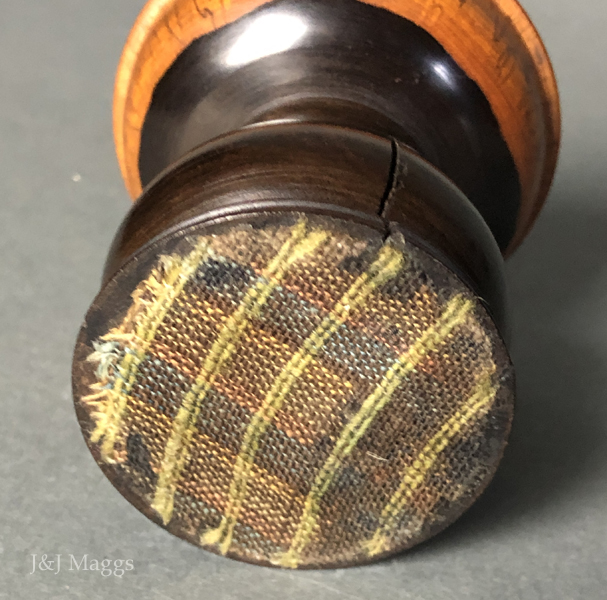Jan & John Maggs
Antiques and Art
Small lignum vitae sander or pounce pot
~ ~ ~ ~ ~ ~ ~ ~ ~ ~ ~ ~ ~ ~ ~ ~ ~ ~ ~ ~ ~ ~ ~ ~ ~ ~ ~ ~ ~ ~ ~ ~ ~ ~ ~ ~ ~ ~ ~ ~ ~ ~ ~ ~ ~ ~

Sanders, or pounce pots, were made in many shapes and in both wood and metal versions. Their purpose was to hold “sand”, a granular material not typically derived from stone, but from ground cuttlefish bone or a resin from the sandarac tree. This latter material is thought by some to be the source of the word “sand”. The pounce was shaken over wet ink, which presumably dried more quickly than if left to bleed through the fibers of the paper of the day.
The wooden forms are our favorites, and of those, this bulbous example wins our highest regard. The piece was turned from a single block of wood, and its interior was hollowed out on a lathe. After the turning was complete, several small holes were drilled into the shallow cupped top, and a plug was inserted into the bottom, which was then covered with fabric.
The holes drilled into the top were arranged in a pattern, and various star shapes, like the one in this sander, are the most common. The pounce material was poured into the shallow bowl and then eased through the holes using a finger. After use, the drying material could be returned to the sander as it was first introduced, giving us an example of an early recycling practice.
This is a fine example of 18th century treenware and of lignum vitae as a material of beauty. The age crack beneath the bowl is a natural result of shrinkage during the drying cycle. Sanders are quite collectible, and this is a great addition to a collection or a fine example with which to begin one.
Diameter: 2 ⅞”; Height: 2 ¾”
English, ca. 1790
Holiday Gift Fest Price: $95
Free domestic shipping is available on Gift Fest purchases totaling $125 or more.
Questions? Click HERE.
Inventory #27340
~ ~ ~ ~ ~ ~ ~ ~ ~ ~ ~ ~ ~ ~ ~ ~ ~ ~ ~ ~ ~ ~ ~ ~ ~ ~ ~ ~ ~ ~ ~ ~ ~ ~ ~ ~ ~ ~ ~ ~ ~ ~ ~ ~ ~ ~



~ ~ ~ ~ ~ ~ ~ ~ ~ ~ ~ ~ ~ ~ ~ ~ ~ ~ ~ ~ ~ ~ ~ ~ ~ ~ ~ ~ ~ ~ ~ ~ ~ ~ ~ ~ ~ ~ ~ ~ ~ ~ ~ ~ ~ ~
Click HERE to visit the Jan & John Maggs Antiques website.